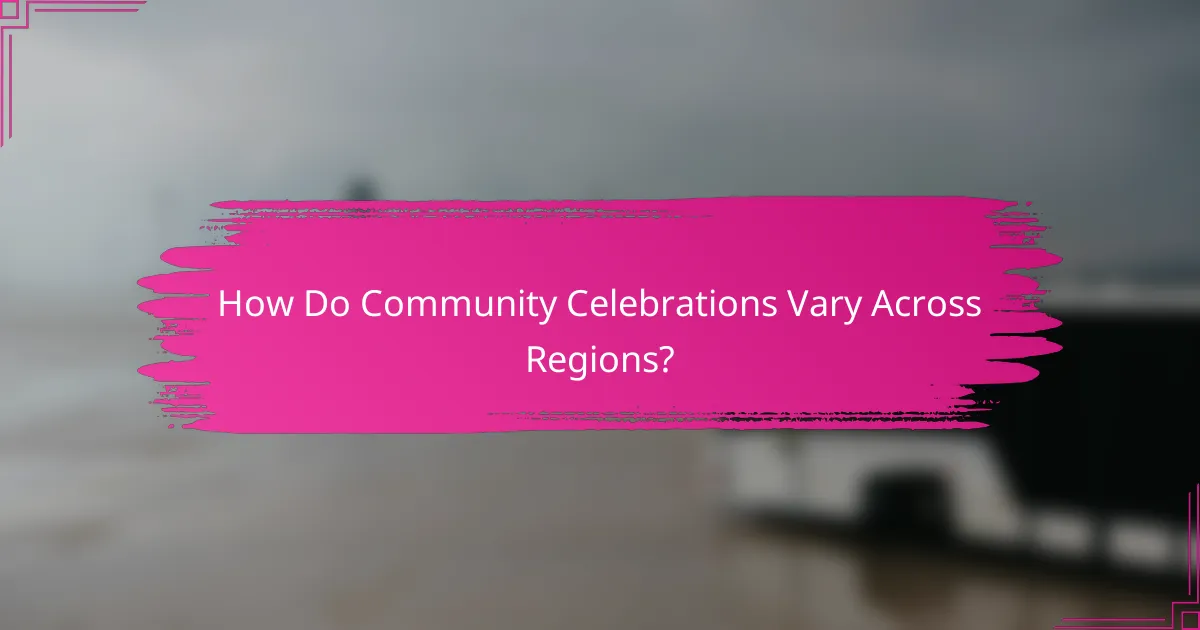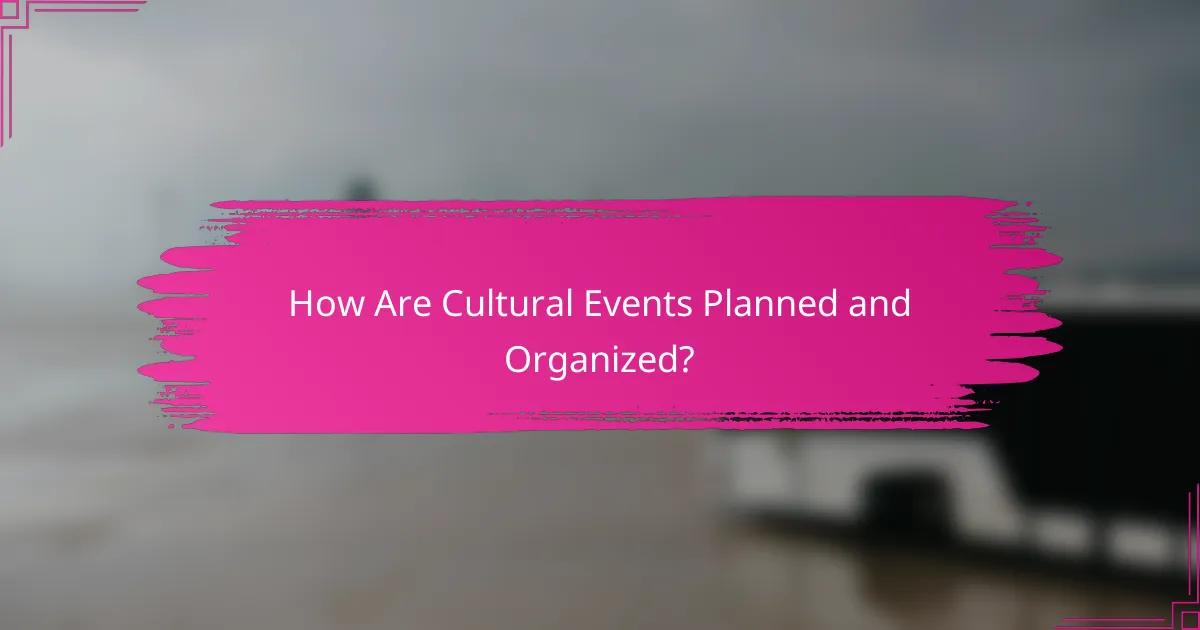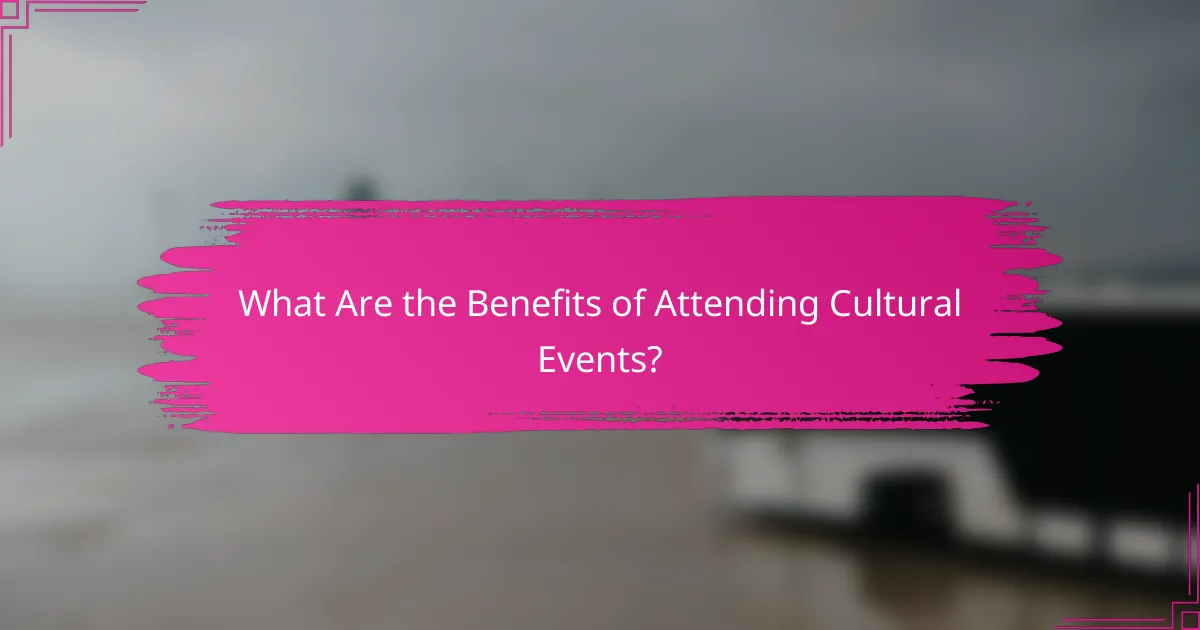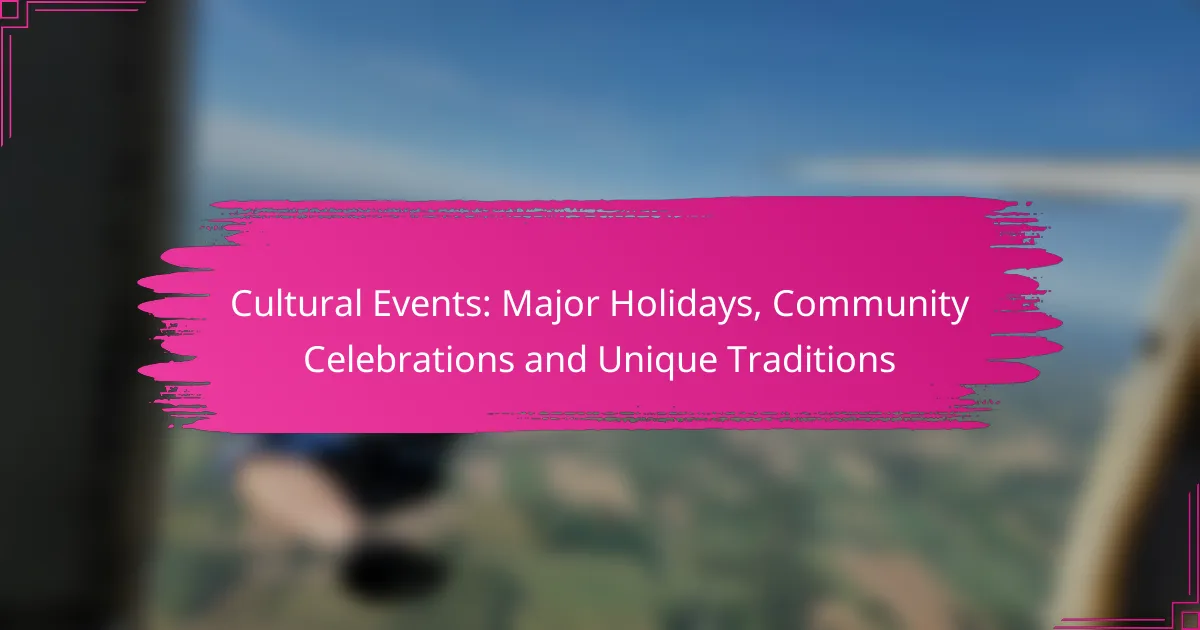Cultural events play a vital role in shaping community identity and fostering connections among individuals. Major holidays such as Thanksgiving and Independence Day, along with regional celebrations, showcase the rich tapestry of traditions that reflect the diverse history and values of different communities. Unique customs, whether festive or solemn, provide insight into the beliefs and practices that define various cultures.

What Are the Major Holidays Celebrated in the United States?
The United States celebrates several major holidays that reflect its diverse culture and history. Key holidays include Thanksgiving, Independence Day, Christmas, New Year’s Day, and Memorial Day, each with unique traditions and significance.
Thanksgiving
Thanksgiving is celebrated on the fourth Thursday of November and is a time for families to gather and give thanks for the harvest and blessings of the past year. Traditional meals typically include turkey, stuffing, and pumpkin pie.
Many Americans also participate in community events, such as parades and volunteer opportunities to help those in need. It’s common to reflect on gratitude and spend quality time with loved ones during this holiday.
Independence Day
Independence Day, or the Fourth of July, marks the adoption of the Declaration of Independence on July 4, 1776. This holiday is celebrated with fireworks, barbecues, and patriotic displays across the country.
Communities often host parades featuring marching bands and floats, while families gather for picnics and outdoor activities. It is a day to honor the nation’s history and celebrate freedom.
Christmas
Christmas is celebrated on December 25 and commemorates the birth of Jesus Christ. It is a major cultural and religious holiday, marked by gift-giving, festive decorations, and family gatherings.
Many people decorate Christmas trees and exchange cards, while others attend church services. Traditions vary widely, with some families incorporating unique customs that reflect their heritage.
New Year’s Day
New Year’s Day is celebrated on January 1 and marks the beginning of the new calendar year. Many people observe this day with parties, fireworks, and various traditions aimed at bringing good luck for the year ahead.
Common customs include making resolutions, watching parades, and enjoying festive meals. In some regions, specific foods are eaten to symbolize prosperity and health.
Memorial Day
Memorial Day is observed on the last Monday of May and honors the men and women who died while serving in the U.S. military. It is a time for remembrance and reflection, often marked by ceremonies and the decoration of graves.
Many Americans also take this opportunity to spend time with family and friends, often enjoying barbecues and outdoor activities. It serves as a reminder of the sacrifices made for the nation’s freedom.

How Do Community Celebrations Vary Across Regions?
Community celebrations differ significantly across regions, influenced by local culture, history, and traditions. These events can range from large-scale festivals to intimate gatherings, each reflecting the unique identity of the community.
Local Festivals
Local festivals are often rooted in cultural or historical significance, celebrating everything from harvests to religious events. For instance, the Oktoberfest in Germany showcases traditional beer culture, while Diwali in India highlights the victory of light over darkness. These festivals typically feature local cuisine, music, and art, creating a vibrant atmosphere.
When planning to attend a local festival, consider the timing and location, as many events occur annually and can attract large crowds. It’s wise to check local calendars for specific dates and any entry fees that may apply.
Parades and Fairs
Parades and fairs are lively community events that often coincide with holidays or special occasions. They feature colorful floats, performances, and various vendors offering food and crafts. Events like the Macy’s Thanksgiving Day Parade in the United States or the Carnival parades in Brazil are prime examples of how these celebrations bring communities together.
Participating in a parade or fair can be a great way to experience local culture. Arrive early to secure a good viewing spot, and be prepared for varying weather conditions. It’s advisable to check if any items are prohibited, such as large bags or outside food, to ensure a smooth experience.
Seasonal Events
Seasonal events mark the changing of the seasons and often include activities like apple picking in the fall or summer solstice celebrations. These events can be family-friendly and typically involve outdoor activities, local produce, and community bonding. Examples include spring flower festivals and winter holiday markets.
To make the most of seasonal events, consider participating in activities that interest you, such as workshops or guided tours. Be mindful of local customs and traditions that may enhance your experience, and check for any seasonal variations in event schedules or offerings.

What Unique Traditions Are Found in Different Cultures?
Unique traditions across cultures often reflect their history, values, and social practices. These customs can range from festive celebrations to solemn rituals, each offering insight into the community’s identity and beliefs.
Dia de los Muertos
Dia de los Muertos, or Day of the Dead, is a Mexican tradition celebrated on November 1st and 2nd. This vibrant holiday honors deceased loved ones with altars, offerings, and festive gatherings. Families create ofrendas, or altars, adorned with photos, favorite foods, and marigolds to welcome the spirits back to the living world.
During this time, communities often host parades featuring colorful costumes and sugar skulls. It is essential to approach this celebration with respect, understanding its significance as a joyful remembrance rather than a mournful occasion.
Chinese New Year
Chinese New Year, also known as Lunar New Year, is celebrated by millions worldwide, typically between late January and mid-February. The festival lasts for 15 days, culminating in the Lantern Festival. Families gather for reunion dinners, exchange red envelopes with money, and partake in various customs to usher in good fortune for the year ahead.
Key traditions include cleaning the house to sweep away bad luck, decorating with red lanterns, and performing dragon and lion dances. Each year is associated with a specific animal from the Chinese zodiac, influencing the year’s characteristics and fortunes.
Holi
Holi, the Festival of Colors, is a Hindu celebration marking the arrival of spring, typically occurring in March. This joyous event involves throwing colored powders, singing, and dancing, symbolizing the victory of good over evil and the arrival of new beginnings. Holi encourages forgiveness and the strengthening of relationships.
Participants often prepare special foods, such as gujiya (sweet dumplings), and gather with friends and family to celebrate. It is important to use natural colors to avoid skin irritation and to respect the cultural significance of the festival while participating in the festivities.

How Are Cultural Events Planned and Organized?
Cultural events are typically planned and organized through a collaborative process involving community members, local organizations, and various stakeholders. Key steps include identifying the event’s purpose, securing funding, obtaining necessary permits, and ensuring community participation.
Community Involvement
Community involvement is crucial for the success of cultural events. Engaging local residents and organizations fosters a sense of ownership and pride, which can enhance attendance and participation. Organizers should consider forming committees or advisory boards that include diverse community voices to ensure the event reflects local culture and interests.
To facilitate involvement, organizers can host planning meetings, distribute surveys, or create social media groups where community members can share ideas and feedback. This approach not only builds enthusiasm but also helps identify volunteers who can assist with logistics and activities during the event.
Funding and Sponsorship
Funding and sponsorship are essential for covering the costs of cultural events. Organizers should explore various funding sources, including local government grants, private donations, and corporate sponsorships. Establishing partnerships with local businesses can provide financial support while also promoting their brand within the community.
When seeking sponsorship, it’s important to clearly outline the benefits for sponsors, such as advertising opportunities or community goodwill. A well-prepared sponsorship proposal can significantly increase the chances of securing necessary funds.
Permits and Regulations
Obtaining the necessary permits and adhering to local regulations is a critical step in planning cultural events. Depending on the location and type of event, organizers may need permits for public gatherings, food sales, or alcohol distribution. It’s advisable to check with local authorities early in the planning process to understand the specific requirements.
Failure to secure the appropriate permits can lead to fines or event cancellation. Organizers should create a checklist of required permits and deadlines to ensure compliance with local laws. Engaging with local officials can also help clarify any regulations that may impact the event’s logistics or safety measures.

What Are the Benefits of Attending Cultural Events?
Attending cultural events offers numerous benefits, including fostering community connections and enhancing personal knowledge. These gatherings provide opportunities to engage with diverse traditions, learn about different cultures, and build relationships within the community.
Community Engagement
Cultural events serve as a platform for community engagement, bringing together individuals from various backgrounds. Participating in local festivals, parades, or art exhibitions can strengthen neighborhood ties and promote a sense of belonging.
Volunteering at these events is another way to enhance community involvement. Consider helping with setup, organization, or cleanup, which not only supports the event but also connects you with fellow community members.
Education and Awareness
Attending cultural events increases education and awareness about different customs and traditions. For instance, festivals celebrating ethnic heritage often include workshops, performances, and discussions that provide insights into the history and significance of those cultures.
To maximize your learning experience, actively participate in activities and engage with speakers or performers. This interaction can deepen your understanding and appreciation of the cultural diversity within your community.
